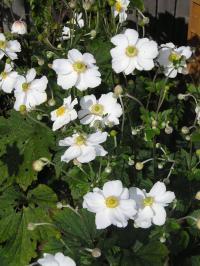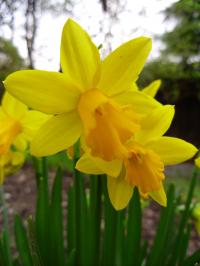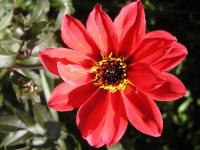The Garden in September
 Japanese Anemone (Anemone x hybrida ‘Honorine Jobert’)
Japanese Anemone (Anemone x hybrida ‘Honorine Jobert’)A guide to some of the jobs that need to be done in September and a selection of some of the plants that are at their best during the month.
The arrival of the month of September can sometimes bring a brief extension of summer, or it can herald the start of autumn. The weather can be warm and dry, which can be annoying if the summer has been wet and the children are just getting back to school.
September can often be a quiet month in the garden, as we await the spectacle that is autumn colour. Other interest in the garden can be hard to come by at this time of year, but there are many plants that look their best during the month of September, making it another enjoyable month to be in the garden.
Jobs to do this Month
Transplant Evergreen Trees and Shrubs
September is a good month to move evergreen trees and shrubs if you feel that you want to reposition them within the garden, or maybe just re-organise a border.
Ideally the plants to be moved will not have been in their current location for too long, the younger the plant the better the chance of success with a transplant.
The first thing to do is to prepare the new hole that the plant is to be moved in to. You need to do this first so that the plant to be transplanted is out of the ground for the minimum amount of time to prevent the roots drying out.
Once you have dug the new hole and forked in lots of well rotted compost or manure into the base it is time to dig up the plant you want to transplant.
Don't rush this bit and dig as deep as you can to limit any root damage and to finish up with the biggest possible rootball. Don't try and lift the rootball by yourself into the new hole, get some help. Crucially, make sure the top of the rootball is level with the soil surface and then backfill the soil around the rootball, firming it in as you go with your feet.
Finally, water the transplanted tree or shrub daily as there is bound to have been some root damage when you dug it up, consider the plant to be in 'intensive care' for a few weeks following the transplant.
Plant Spring Bulbs

Bulbous plants that flower in spring can be planted in September. Examples incude Daffodils, Winter aconites, Crocuses, Hyacinths and Scillas.
Use the suppliers planting instructions for each differnet variety of bulb, plant at the correct depth and make sure you leave enough space between each bulb in the planting hole.
If you have clay soil in your garden incorporate plenty of grit or sand into the planting hole and around the tops of the bulbs when you place them in the holes to prevent the bulbs from rotting in wet weather.
Sow Grass Seed or Lay Turf
September is a very good month to sow grass seed for a new lawn lawn or lay turf, or you might have patches of an otherwise good lawn that need re-seeding / repairing. The weather in September is usually ideal becuase the chances of rainfall are higher whilst the soil retains some of the summer heat.
In the Vegetable Garden
Sow seeds inside of: Lettuce.
Sow seeds outside of: Radish.
Harvest: Peas, French beans, Tomatoes, Onions, Radish, Carrots, Turnips, Beetroot, Spinach, Cauliflowers, Lettuce, Globe artichokes, Courgettes, Cucumbers, Swiss chard, Broccoli, Sweetcorn, Aubergines, Peppers, Pumpkins and Brussels sprouts.
Other Jobs
September has traditioanlly been a month for planting, with rainfall likely and soil that is still warm it's a good time to establish new plants before the winter months.
- Dead-heading
- Regular lawn mowing (raise the height of cut in very dry weather)
- Trim border edges
- Regularly spray roses against greenfly and blackspot
- Water and feed containers and hanging baskets regularly
- Take cuttings of pinks and carnations
Our Plant of the Month
 Dahlia ‘Bishop of Llandaff’
Dahlia ‘Bishop of Llandaff’
This strikingly coloured Dahlia flowers throughout the summer and on into September. Dahlia 'Bishop of Llandaff' has striking bright red, semi-double flowers and contrasting dark bronze-red divided foliage.
A sunny site is best for this Dahlia with fertile, humus rich soil. I have seen Dahlias that survive every winter but if you want to play it safe, the tubers need to be lifted and stored. The flowers of Dahlia 'Bishop of Llandaff' are good for cutting.
For the best flowering performance, feed the plants with a nitrogen rich fertiliser weekly in June, then a potash rich fertiliser weekly from July to September. Dahlia ‘Bishop of Llandaff’ grows to a maximum height of 1 metre, and a maximum spread of 50cm.
Perfect Pairing
Two Plants that Complement Each Other this Month
Anemone × hybrida 'Königin Charlotte' (syn. Queen Charlotte ) and Hydrangea macrophylla 'Zambia'
This month’s pairing provides some welcome late summer colour providing you like the colour pink. The Japanese anemones are one of my favourite groups of plants for the month of September. Anemone x hybrid 'Königin Charlotte' (syn. Queen Charlotte ) grows to a height of 1.5 metres and will grow well in almost any soil and once established will tolerate dry semi-shade. The pink flowers of Anemone x hybrid 'Königin Charlotte' (syn. Queen Charlotte ) are produced from August until October.
Hydrangea macrophylla ‘Zambia’ is a recently introduced cultivar that will look good planted in front of the Japanese anemone because it does not grow as quite as tall. It flowers for an even longer period than the anemone from June to October. The flowers are a deeper, more intense pink than those of the Japanese anemone and they are complimented by almost black stems. Like the anemone, Hydrangea macrophylla ‘Zambia’ will also grow and flower well in partial shade.
Other Plants of Interest this Month
Filed under General.

